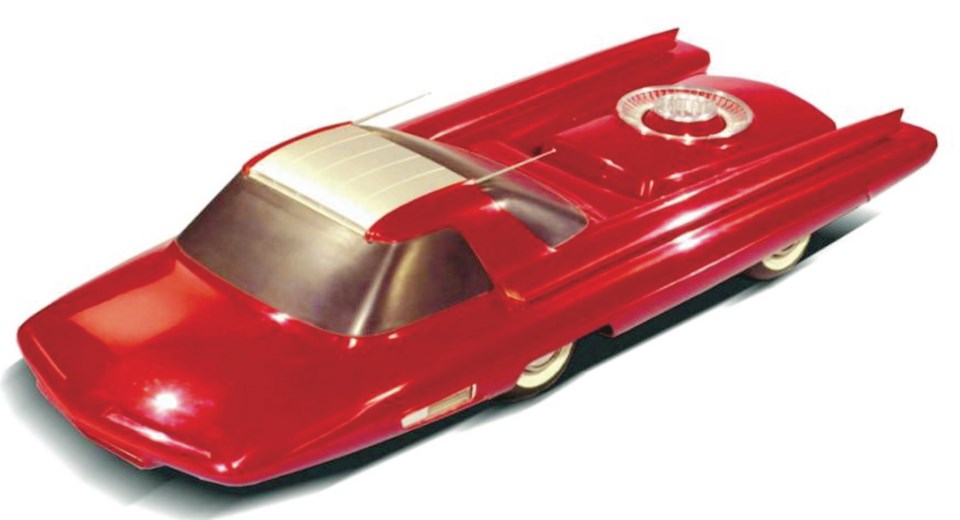When the United States dropped atomic bombs on Nagasaki and Hiroshima, Japan, in August 1945, it not only ended the Second World War in Japan, it initiated the nuclear age.
While deeply mysterious to most people, some began wondering if the atom really was the awesome new source of energy that magazines such as Popular Mechanics had begun predicting in the 1940s. Could a cheap, pea-sized nuclear pellet really power your car for a year?
This was long before the Three Mile Island and Chernobyl nuclear catastrophes, a time when nuclear power was seen as another of the blessings science could harness for civilian convenience and pleasure.
It was part of the boundless do-anything optimism that followed the Second World War, especially in the United States. Military technology could be turned to peaceful use for humanity’s benefit, and there was an almost blind faith in science. And was there a more ubiquitous application than the nuclear-powered automobile?
It wasn’t long into the atomic age before an authoritative voice seemed to reinforce this naive faith in nuclear technology. In 1945, William Stout, a somewhat offbeat but brilliant and futuristic engineer, designer of the Ford tri-motor airplane and 1930s Stout Scarab minivan-like vehicle, predicted there would be atomic-powered cars in our future. It was a bold prophesy, although he hedged his bet by saying gasoline would still be used for a long time.
Besides the craft magazines, some of the motoring press would get on the nuclear bandwagon. Motor Trend’s April 1951 edition featured a cover rendition of a futuristic, eight-wheeled, finned extravaganza with a bubble windshield and the caption: Exclusive! “Tomorrow’s Atom Car!” More conservative Road & Track did not mention it.
What seemed to be overlooked or downplayed were the many barriers to a nuclear car, the most obvious being that no nuclear reactor had yet been produced that was small enough for an automobile.
There was also the reality that nuclear fission emitted deadly radiation that was invisible, tasteless and odourless. The weight of the shielding required to protect people would make a car prohibitively heavy — some estimated up to 50 tons. This was either not understood or conveniently forgotten. Or perhaps there was confidence that science could create shielding light enough for automobiles.
The result was that many people continued to believe that nuclear power would find its way into cars.
In spite of their great coteries of knowledgeable engineers and scientists, automobile companies were not immune to this public infatuation. Chrysler Corp. designed a futuristic-looking nuclear car with passengers well forward of the wheels to keep them far from the reactor. It didn’t get past paper illustrations.
Studebaker-Packard designed a futuristic-looking fibreglass dream machine they called the Astral. Nothing came of it.
Benson Ford, grandson of Henry Ford and an executive with Ford Motor Co., encouraged members of the Society of Automotive Engineers to design a nuclear-powered car.
Ford already had an underground lab in Dearborn that was experimenting with the use of radio isotopes in metal inspection so they were not entirely ignorant on the subject. It was therefore not surprising that Ford ventured farthest down the atomic car trail in 1958 — even if it did not go all out and create a full size prototype.
Ford’s “atomic car,” called the Nucleon, was a 3/8 scale model about 1,905 millimetres long. Realizing they must keep passengers and the atomic powerplant as far apart as possible, the Nucleon resembled an extended pickup truck with the sides of the box looking like long booms. Being the 1950s, it had huge tailfins.
To keep maximum separation between passengers and radiation, the nuclear reactor would be located at the very rear over the axle where a pickup bed would normally be. The passenger cabin was perched far forward with the driver ahead of the front wheels. This unusual profile with sleek nose, narrow slit headlamps and wraparound windshield gave it a very futuristic appearance.
Nuclear fission in the small reactor would heat water to produce steam that spun turbines, primarily to power the car, but also generate electricity. The steam was condensed back to water and was re-used, and the reactor could be exchanged after many thousands of kilometres. It was similar to the system used in nuclear submarines.
The Nucleon didn’t get past that scale-model stage but it was still the boldest move by an auto company, demonstrating that Ford was at least thinking ahead. Alas, there were too many strikes against atomic cars.
After its demonstration days were over, the Nucleon was stored away for many years, not destroyed like so many concept cars.
This tiny chimerical chapter in automotive history is now in the Henry Ford Museum in Dearborn, Michigan.



